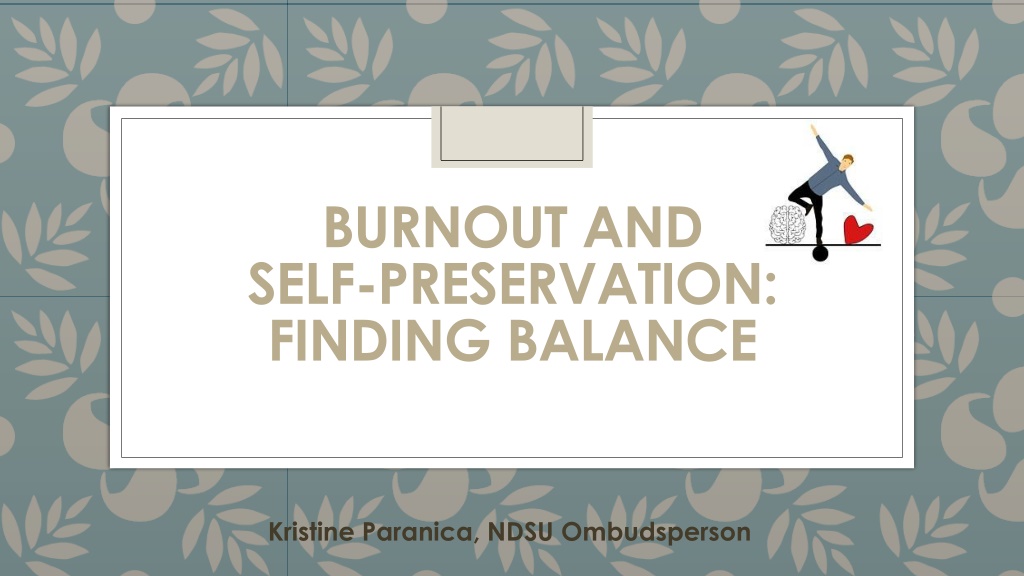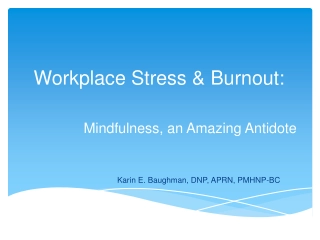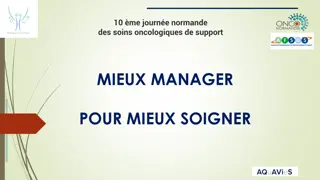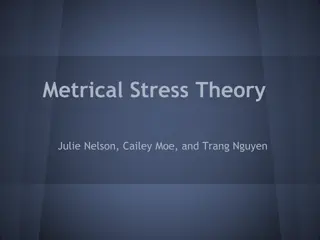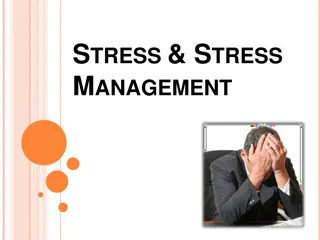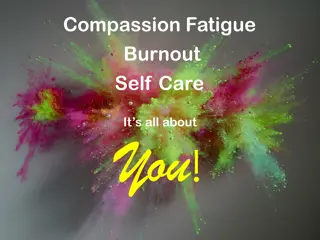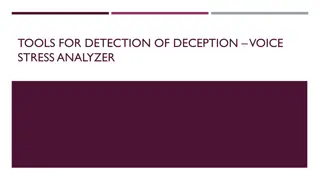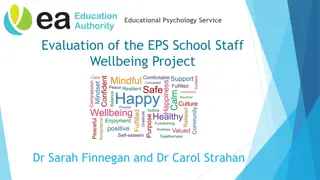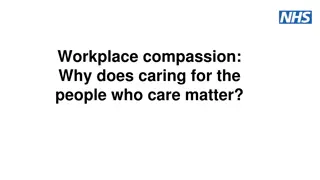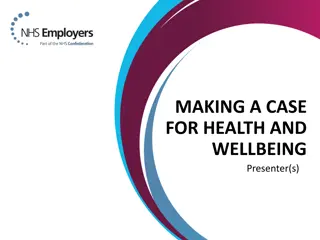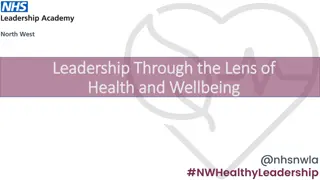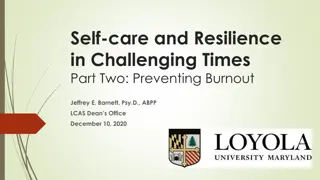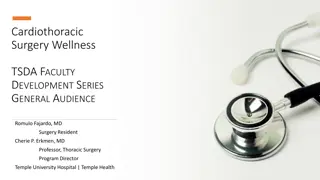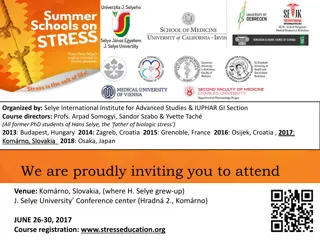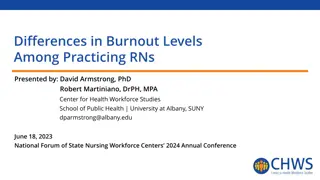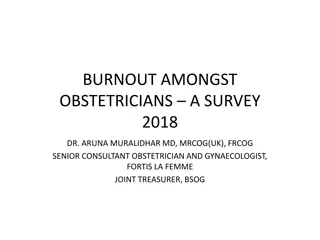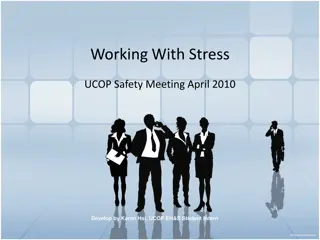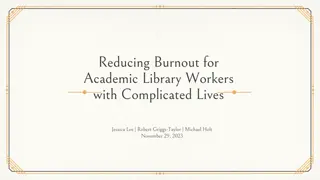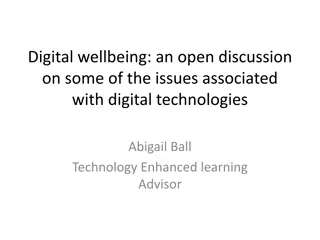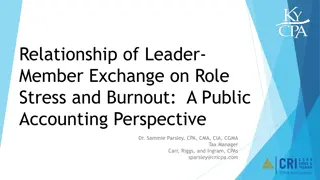Managing Stress and Burnout for Better Wellbeing
Understanding stress, burnout, and their impacts on wellness. Learn to differentiate stress from anxiety, identify support strategies, evaluate current wellness levels, and create a plan for reducing stress and burnout. Engage in activities to assess reactions to stress and debunk common myths surrounding burnout.
Download Presentation

Please find below an Image/Link to download the presentation.
The content on the website is provided AS IS for your information and personal use only. It may not be sold, licensed, or shared on other websites without obtaining consent from the author.If you encounter any issues during the download, it is possible that the publisher has removed the file from their server.
You are allowed to download the files provided on this website for personal or commercial use, subject to the condition that they are used lawfully. All files are the property of their respective owners.
The content on the website is provided AS IS for your information and personal use only. It may not be sold, licensed, or shared on other websites without obtaining consent from the author.
E N D
Presentation Transcript
BURNOUT AND SELF-PRESERVATION: FINDING BALANCE Kristine Paranica, NDSU Ombudsperson
OBJECTIVES Define stress and burnout Identify support strategies to manage stress and burnout Evaluate current level of wellness Create a plan to decrease stress and burnout Check Check- -in: in: how would you rate your current stress/burnout? ? On a scale of 1 On a scale of 1- -10 10 (10 being highest, 1 being lowest), (10 being highest, 1 being lowest), how would you rate your current stress/burnout
Stress is a feeling of emotional or physical tension, including frustration, anger, nervousness. Stress is your body's reaction to a challenge or demand (positive or negative). Defining Stress Stress can be acute, episodic, or chronic Chronic stress can increase risk of: anxiety, depression, memory/concentration losses (World Health Organization, 2019)
Stress Vs. Anxiety Stress Anxiety Caused by past, current, or anticipated future demands and pressures, feeling overwhelmed Fear based with intense feelings of worry and often hopelessness and/or helplessness Often a common reaction to persistent stress Typically long-term, at least six months, and does not always a known cause Common signs of anxiety include: Irritability, muscle tension, headaches, upset stomach, sweaty palms, rapid heartbeat, dizziness, changes in sleep, appetite, or concentration Typically short-term and situational Stress can be motivating Common signs of stress include: Irritability, muscle tension, headaches, upset stomach, sweaty palms, rapid heartbeat, dizziness, changes in sleep, appetite, concentration (Block & Block, 2012)
Activity: Small Group Check-in How do you typically react in stressful situations (e.g., behaviors, emotions, relational dynamics)? What have you noticed about other s reactions in stressful situations in your department or on your campus? Identify current stressors in your department and/or on your campus.
Activity: Burnout Fact or Myth Let s check-in with thumbs up (fact) or thumbs down (myth): There are so many more important issues than burnout. Burnout is a sign of weakness. Burnout is normal in activism. Now we have to deal with more important things, when it s over we can take care of ourselves. Taking care of yourself when other people s lives are at stake is selfish. Burnout requires major work or life change. A vacation or a day off will solve your burnout. My burnout is only my responsibility.
Burnout by the Numbers 78% of employees report stress from work has led to other mental health concerns 80% of employees report workplace stress affects their relationships with friends, family, and coworkers 71% of employees report difficulty concentrating at work 56% of surveyed employees spent time looking for a new position (compared to 40% in 2018) (Mental Health America, 2022)
What is burnout? Signs of Burnout: Exhaustion: Drained, emotionally exhausted, unable to cope, down, lack of energy, no more cares to give Cynicism: Critical of working conditions and colleagues, negativism, distancing, feeling numb, decreased empathy and compassion Reduced performance: Negative about tasks, difficulty concentrating, listless, lack of creativity , reduced professional efficacy A syndrome conceptualized as resulting from chronic workplace stress that has not been successfully managed Refers specifically to the workplace and should not be applied to other areas of life (Nagoski & Nagoski, 2020; World Health Organization, 2019)
Activity: Small Group Check-in What signs of burnout have you experienced? What does burnout look like for you? What consequences of burnout have you and your department/campus experienced? Consider the previous identified stressors in your department or on your campus, are they associated more with stress or burnout at this point?
Unlocking the Stress Cycle The cure for burnout is not self-care. The cure for burnout is all of us caring for each other. Knowing and following a well-defined and shared purpose so we can more easily recommit ourselves, see value in our work, and toward change. (Nagoski & Nagoski, 2020) Practice Compassion giving grace to ourselves and others, our colleagues and students. At the institutional level, offer flexibility, to build community and find connections across identity groups informally, provide and use mental health resources, etc. Deepen connections between you and others by reaching out. Use the Counseling Center, the Ombuds Office, and other resources to facilitate dialogue and workshops around these topics. Feeling like you aren t the only one; being seen and heard are critical. Pursuing Realistic Balance. Leaders can model work-life balance by committing to exercise, hobbies, free time, and avoiding weekend and evening email. Ensuring equity in workloads in departments and colleges. (Pope-Ruark, R., 2022; Nagoski & Nagoski, 2020)
Activity: Exploring Burnout Strategies What has worked for you? How have you managed burnout? How do (or can) you help others managing burnout? What can you department do as a whole to promote wellness? What do you need from your workplace to promote wellness?
What is wellness? The Global Wellness Institute defines wellness as the active pursuit of activities, choices, and lifestyles that lead to a state of holistic health. Wellness is... NOT passive or static About active intentions Holistic in encompasses multiple dimensions of life An individual journey
References Block, S. H., & Block, C. B. (2012). Mind-body workbook for stress: Effective tools for lifelong stress reduction and crisis management. Oakland, CA: New Harbinger Publications. Global Wellness Institute (2021). What is wellness? Retrieved from: https://globalwellnessinstitute.org/what-is-wellness Mental Health America (2022). Mind the workplace: Employer responsibility to employee mental health. Retrieved from: https://mhanational.org/sites/default/files/MTW_Report_2022.pdf Nagoski, E. & Nagoski, A. (2020). Burnout: The secret to unlocking the stress cycle. Ballantine Books Trade: New York, NY. Pope-Ruark, R. (2022). You ve Burned Out. Now what? The Chronicle. Retrieved from: https://www.chronicle.com/article/youve-burned-out-now-what Pope-Ruark, R. (2022). Unraveling Faculty Burnout: Pathways to Reckoning and Renewal. Johns Hopkins University Press: Baltimore, MA. World Health Organization (2019). Burn-out an occupational phenomenon : International classification of diseases. Retrieved from: https://www.who.int/news/item/28-05-2019-burn-out-an- occupational-phenomenon-international-classification-of-diseases PowerPoint Template from: www.fppt.com
